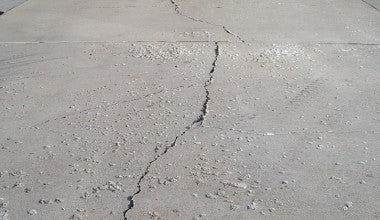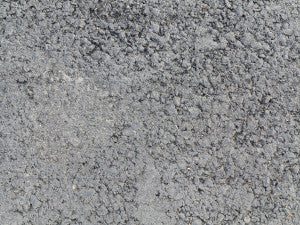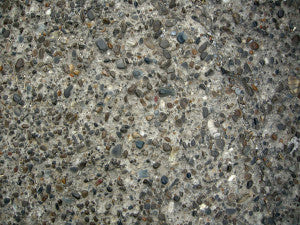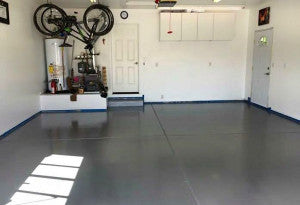Concrete
Concrete accounts for 99% of garage floors due to it's low cost and relative ease of installation. There are three key things to consider when looking at installing a threshold seal on a concrete floor; The condition of the floor; the finish of the floor and what covers the surface of the floor.
Let's start with the condition of the floor.
The condition of the floor will determine whether or not the threshold will work at all, with any cracks, dips or pot holes being an issue that needs to be fixed prior to installing your threshold seal.

If you have any cracks in the area that the threshold is going to be installed, water will naturally find it's way under the threshold and inside. This can be remedied using either a concrete floor patch kit or epoxy resin, depending on the size and location of the crack. An example of a crack repair kit can be found here:

If you have any potholes in the floor, or any areas where the concrete is loose, this needs to be fixed with a concrete repair/patch kit, making sure to remove any loose concrete first. A great product for this can be found here:
https://www.homedepot.com/p/Sika-1-Gal-Ready-Mix-Concrete-Patch-514899/207086494
The next thing to consider is the floor's finish.
The most common type of concrete finish, semi-smooth with small surface cracks.
For a semi-smooth floor (as pictured above) a liberal application of adhesive will provide ample protection without any additional work needed. The small cracks in the surface will be filled with adhesive when the threshold seal is pressed down firmly during the installation.

Another type of concrete finish, common in older garages; a very gravelly finish made up of small stones.
If you have a very rough finish (like the image above), with large stones in it, you may need to smooth the surface back with an angle grinder prior to moving forward with the preparation. A finish with smaller stones can be OK provided lots of adhesives is used to flood the small gaps created by the stones.
The next thing to consider is what covers the concrete's surface.
"Raw Concrete"
The surface of the concrete by its very nature will slowly turn to dust over time. If you imagine sticking something to this dusty surface, not only will the adhesive struggle to get a good grip to begin with but what little grip it gets will quickly begin to loosen as the surface it is adhered to turns to dust. This is only exacerbated by driving over the seal.
To prevent concrete from "dusting" you should apply a concrete sealer to the surface prior to installing your threshold seal.

Concrete sealer is easy to apply and offers the best form of surface for the threshold to stick to.
Sealer bonds the top of the concrete together into a hard and stable surface which will not dust over time. This is the best possible surface for the adhesive to be applied to, not only to give the best grip but also to get the maximum lifespan out of the threshold seal without having to reapply it. Concrete sealer is available at most major hardware stores and is a cheap but incredibly effective way to make the most of your threshold seal. An example of a concrete sealer can be found here
Painted Floors

If you have a painted concrete floor this changes things slightly. Painted floors are problematic for adhering a threshold to as the adhesive sticks to the paint, not the floor. Over time, the paint will peel and the threshold seal will come away. Paint can be removed using a wire brush, exposing the raw concrete underneath. You only need to remove the paint along the area where the threshold is to be installed so it won't affect the aesthetics of the garage, don't worry. Once the paint has been removed, seal the raw concrete as mentioned above to give the best possible surface for the adhesive to bond to.
Epoxy Floors
If you have an epoxy coated floor, you can install the threshold directly onto the epoxy provided it is a relatively thick coating. If your coating is less than a few millimetres there is the chance the cars driving over the threshold will cause the epoxy to lift up, potentially damaging the floor. If you are not sure about the thickness of the epoxy you can cut a section out of it to allow the threshold to "sit" in the gap, adhering directly to the floor underneath. Most professionally poured epoxy floors are sufficiently thick to install a threshold seal onto without any issues.
Tiled Floors

Tiled floors can be tricky as there are so many types and finishes of tiles available. If you have a high gloss tile we would recommend roughing the surface of the tiles in the area where the threshold is to be installed to allow the adhesive to get a good grip. If you have terracotta or similarly porous tile, you can install the threshold onto the tiles directly. Obviously you need to make sure that none of the tiles are loose or cracked as water will find it's way through. With any tiled surface we would recommend doing an adhesion test prior to installation to make sure that your tiles will work well with the adhesive. To do this, simply trim a little of the threshold off and stick it down somewhere inconspicuous and check the adhesion after a few days. If you are happy, proceed with the installation. One thing to note is that the sealant/adhesive needs to be applied to the gaps/grout between the tiles along with the usual installation pattern to ensure no water gets through.
Plastic Floor Tiles

Interlocking or plastic tiles are not suitable for installing a threshold seal onto as they do not offer any direct seal to the floor. They would need to be trimmed to create sufficient space for the threshold seal to be installed directly onto the floor underneath.
In summary, the most important thing to make sure you have is a solid, stable, clean surface for the adhesive to grip to. Provided you have taken the proper care of the floor prior to installation, you can expect many years of hassle-free protection for your garage by using a Garadry floor threshold seal.
